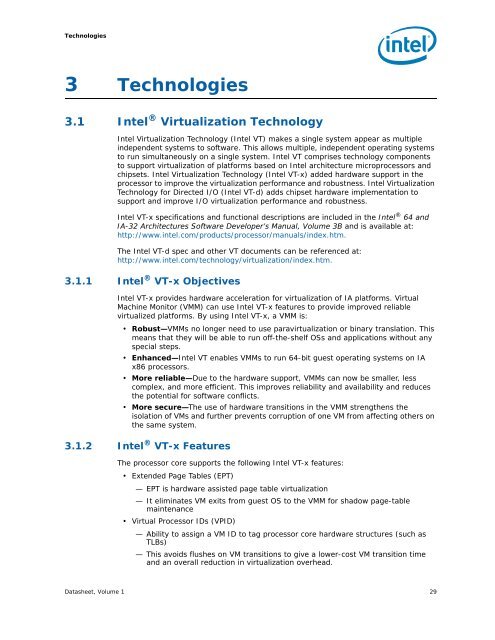You also want an ePaper? Increase the reach of your titles
YUMPU automatically turns print PDFs into web optimized ePapers that Google loves.
Technologies<br />
3 Technologies<br />
3.1 Intel ® Virtualization Technology<br />
Intel Virtualization Technology (Intel VT) makes a single system appear as multiple<br />
independent systems to software. This allows multiple, independent operating systems<br />
to run simultaneously on a single system. Intel VT comprises technology components<br />
to support virtualization of platforms based on Intel architecture microprocessors and<br />
chipsets. Intel Virtualization Technology (Intel VT-x) added hardware support in the<br />
processor to improve the virtualization performance and robustness. Intel Virtualization<br />
Technology for Directed I/O (Intel VT-d) adds chipset hardware implementation to<br />
support and improve I/O virtualization performance and robustness.<br />
Intel VT-x specifications and functional descriptions are included in the Intel ® 64 and<br />
IA-32 Architectures Software Developer’s Manual, Volume 3B and is available at:<br />
http://www.intel.com/products/processor/manuals/index.htm.<br />
The Intel VT-d spec and other VT documents can be referenced at:<br />
http://www.intel.com/technology/virtualization/index.htm.<br />
3.1.1 Intel ® VT-x Objectives<br />
Intel VT-x provides hardware acceleration for virtualization of IA platforms. Virtual<br />
Machine Monitor (VMM) can use Intel VT-x features to provide improved reliable<br />
virtualized platforms. By using Intel VT-x, a VMM is:<br />
• Robust—VMMs no longer need to use paravirtualization or binary translation. This<br />
means that they will be able to run off-the-shelf OSs and applications without any<br />
special steps.<br />
• Enhanced—Intel VT enables VMMs to run 64-bit guest operating systems on IA<br />
x86 processors.<br />
• More reliable—Due to the hardware support, VMMs can now be smaller, less<br />
complex, and more efficient. This improves reliability and availability and reduces<br />
the potential for software conflicts.<br />
• More secure—The use of hardware transitions in the VMM strengthens the<br />
isolation of VMs and further prevents corruption of one VM from affecting others on<br />
the same system.<br />
3.1.2 Intel ® VT-x Features<br />
The processor core supports the following Intel VT-x features:<br />
• Extended Page Tables (EPT)<br />
— EPT is hardware assisted page table virtualization<br />
— It eliminates VM exits from guest OS to the VMM for shadow page-table<br />
maintenance<br />
• Virtual Processor IDs (VPID)<br />
— Ability to assign a VM ID to tag processor core hardware structures (such as<br />
TLBs)<br />
— This avoids flushes on VM transitions to give a lower-cost VM transition time<br />
and an overall reduction in virtualization overhead.<br />
Datasheet, Volume 1 29


